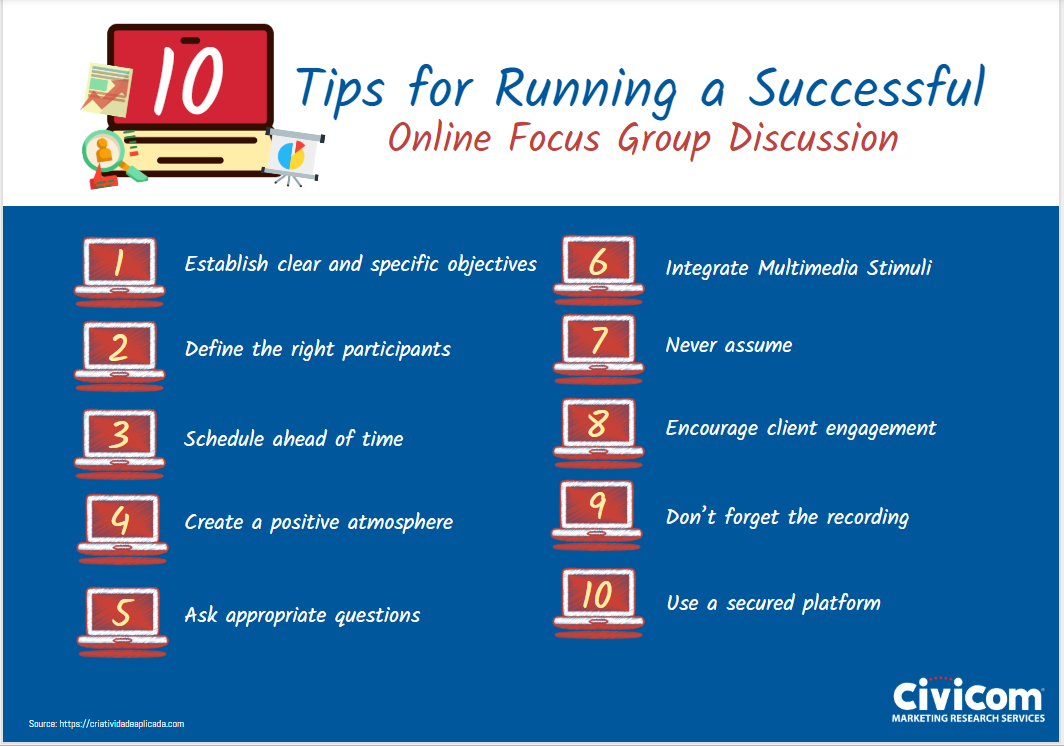How do you best manage a focus group discussion when you are miles away from your respondents?
We are now able to do things anywhere be it within an arm’s length or from the other side of the globe thanks to continuous technological breakthroughs. Advancements in market research are among the many sectors that flourished because of today’s digital progression – so much so that in-depth interviews and focus group discussions can also be conducted online now. Web-enabled IDIs and FGDs are now made available by a lot of research service providers.
Online focus group discussion is a dynamic way to gather quick but detailed feedback from a targeted key group of respondents. It is conducted for the same reason physical FGDs are conducted – to generate insights in order to improve brand perception, increase customer satisfaction, and enhance product development. The online aspect of it just allows people from other parts of the country or the world even to participate in one of these, giving the researcher a wider perspective on the study.
Conducting an online focus group discussion may not require a physical location or your respondents’ physical presence, but it is still not an easy feat.
Tips to Run a Successful Online Focus Group Discussion:
-
Establish clear and specific objectives
You have to understand exactly what you’re trying to accomplish through this FGD. Determine what data you already have and what information is still needed to move the study forward. Ask yourself the following questions before you even begin to recruit for respondents:
- What do I need to know?
- Why do I need to know that?
- What do I hope to achieve from my respondents?
This should give you a clear path on how you can better navigate the discussion and prevent it from straying too far from the main topic.
-
Look for the right participants
Once you’re done establishing the purpose and objectives of your study, your next task is to find the right respondents. The ideal group consists of 6 to 8 participants. This range is just enough to allow an in-depth discussion to take place but it is not too many that it’s barely manageable.
Also, it’s crucial that you consider the right group of people. If your topic is about the branding of sports attire, you should consider athletes first being the primary consumers of those products.
-
Schedule ahead of time
Give your respondents more than a day or two of notice before scheduling them in. You have to consider that they also have other commitments to attend to so scheduling them ahead of time will help you avoid delays. Be sure to stay on top of the schedule that you both agreed to. So if you ask your respondents to make themselves available for an hour, keep it within an hour.
Do note that the ideal amount of time that should be dedicated to your FGD is anywhere between 60 minutes to 90 minutes. Anything longer than that can already cause distractions or mild fatigue, thereby affecting the quality of your discussion.
-
Create a positive atmosphere/a relaxed environment
An online FGD may not be as impactful as the traditional one in terms of the environment, but there are still ways to make the atmosphere comfortable and positive for all the respondents. One way of making it positive for them is by rewarding them with gift cards or gift cheques after every session to increase their enthusiasm to participate.
You can also do a quick virtual ice breaker at the beginning of every session. If you happen to be working on an audio-centric focus group discussion, there are features like Active Talker allowing the participants to distinguish whose voice belongs to who by allowing them to see the names of those who are currently speaking to avoid confusion and the overlapping communication.

-
Ask appropriate questions
Your questions are the heart and soul of your research. This means that your questions should be tailored according to your study’s purpose. Remember to avoid asking questions answerable only by yes or no, and rather focus on open-ended questions (start with who, what, where, why, how) to encourage participants to elaborate on their answers and gather more insightful information. Give everyone a fair chance to offer their opinion on each question.
-
Integrate Multimedia Stimuli
When you design the questions, you can complement them with video, slides, and images as helpful visuals so that your participants are motivated to share more. It will also help break the monotony of using texts, leading to a more dynamic discussion.
The good thing about an online focus group is that your participants are able to watch these stimuli at their own pace or even re-watch them if they need to.
-
Never assume
Make sure to always seek clarity from your participants’ answers. There is no room for assumptions. If they say anything that sounds a bit confusing or hard to understand, you or the moderator should probe more to really understand what they meant. You should end the discussion knowing fully well what each and every one of them meant.
-
Encourage client engagement
There are service providers offering web rooms where clients can communicate with moderators or facilitators and listen in on in-depth interviews and focus group discussions. After all, these clients are individuals or businesses interested in the outcome of the focus group.
-
Don’t forget the recording
You can either do audio or video recording depending on the type of session you’re conducting. This way, you wouldn’t need to hire another person to do the note-taking for you. Recordings ensure more accuracy and can even be transcribed to a readable word document that you can easily look into afterward.
-
Use a secured platform
It’s important that the system or platform you’re using is safe and secured because oftentimes, you will be dealing with very sensitive topics. It’s your responsibility to keep your participants’ personally identifiable information confidential. Go for services that are GDPR and HIPAA compliant and one that offers features such as audio masking and video blurring.
That being said, an online focus group can basically provide all of the benefits a traditional FGD can and even allows for efficiency and cost-effectivity both on the researcher and the respondents’ side.
Conduct Your Online Focus Groups with Quality and Expertise Using Civicom CyberFacility®
Elevate your online IDIs and focus groups for moderators and respondents even when they're located anywhere in the world. We have features that allow for a seamless transition from a web-enabled interview to a web or mobile usability study. Civicom CyberFacility® is here to help you.



